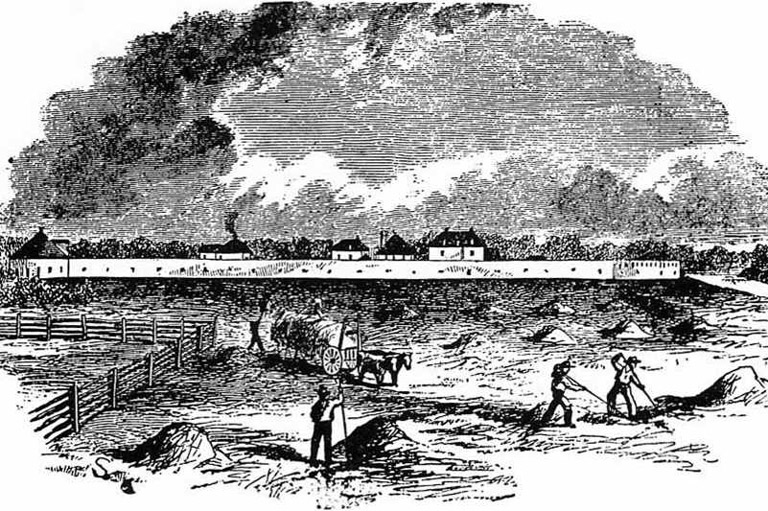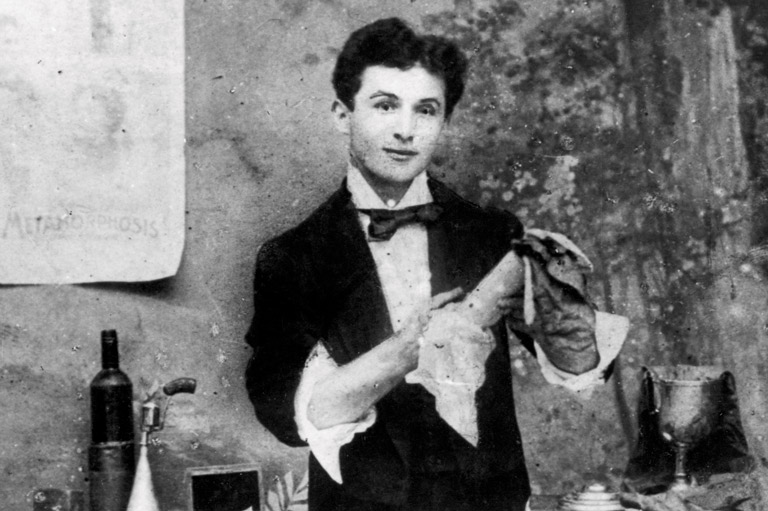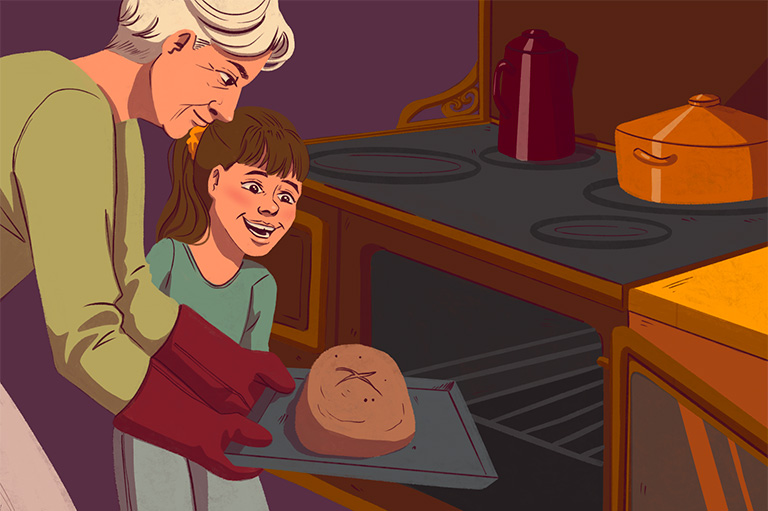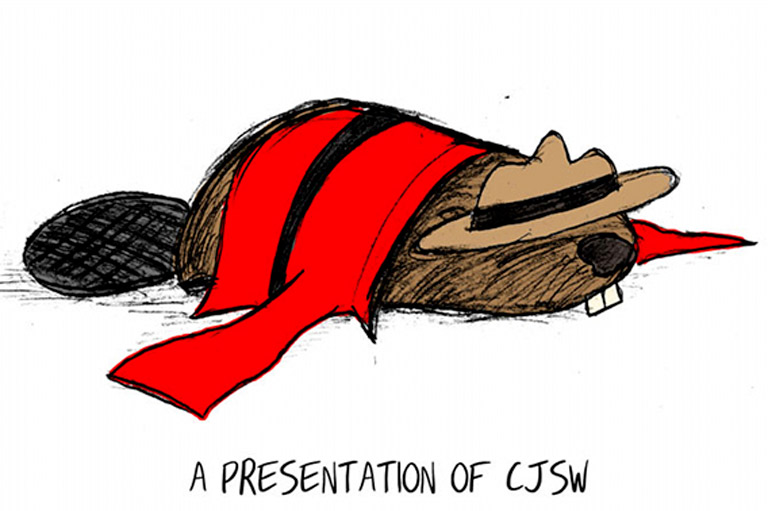Going, Going, Gone

The auctioneer’s chant rolls across my in-laws’ Saskatchewan farmyard in a steady, unbroken cadence: “What amI bid, what amI bid, what amI bid?”
There are four auctioneers in total, all men. Two take turns with the farm and its equipment; two take care of the household goods. These men are good at what they do. Perched in custom-built boxes atop Ford 350s, they smoothly assess the crowd as the lots come up. The auctioneers’ helpers move amongst the onlookers, scanning for potential buyers. At just the right moment, the chief auctioneer launches into yet another round of encouraging the highest bidder, his voice vibrating into a single stream of consciousness:
“Who wants to join in on the bidding on this International grain truck? Five thousand to bid. Yeoh! Now fifty-five hundred to go. Yeoh! Now six thousand to bid. Yeoh! Sold to buyer one four nine — six thousand dollars straight. He’ll enjoy that one.”
I, the city-bred son-in-law, am still uncertain of rural rhythms after a quarter century of visits to the farm my wife grew up on. The auction is exciting, yet I feel a deep melancholy. Feeling the need to escape the action for awhile, I take refuge in the barn, which sits empty for the first time since it was built in 1917. The barn still smells of cattle, even though the last animal was sold off in 1999. A smattering of ancient feed oats remains in one of the feed troughs. The stale fragrance of saddles and leather accoutrements, including a harness for a horse-drawn wagon, lingers in the air.
With 7 uniquely curated newsletters to choose from, we have something for everyone.
I know in my head that my parents-in-law — George and Gladys Brehon — have made the right decision to leave the farm. Both are eighty-six. George has recently had two major surgeries. It’s becoming increasingly difficult to keep the farm up, he tells me. But my heart yearns for them to keep going, for I love the farm with all my heart.
As I stand in the empty barn, perhaps for the last time, I hear the auctioneer make a pitch for a piece of farm equipment — “George is going to run this for us right now … hasn’t used it very much … two hydraulics brand new.” — and I think back on what I have learned about the farm and its history.
George’s father, Alex Brehon, established the farm at the turn of the twentieth century. Alex and two of his brothers had been sent to Canada from Ireland by their family in the hope that they would escape the ravages of tuberculosis, which was then at epidemic levels. In 1902, Alex took out a homestead claim at a location between Saskatoon and North Battleford. On the map, the property is Southwest Section 24 Township 42 Range 12 West of the Third Meridian — SW24-T42-R12-W3 for short — near the village of Maymont. Alex named the homestead the Emerald Farm, to remind him of his Irish birthplace.
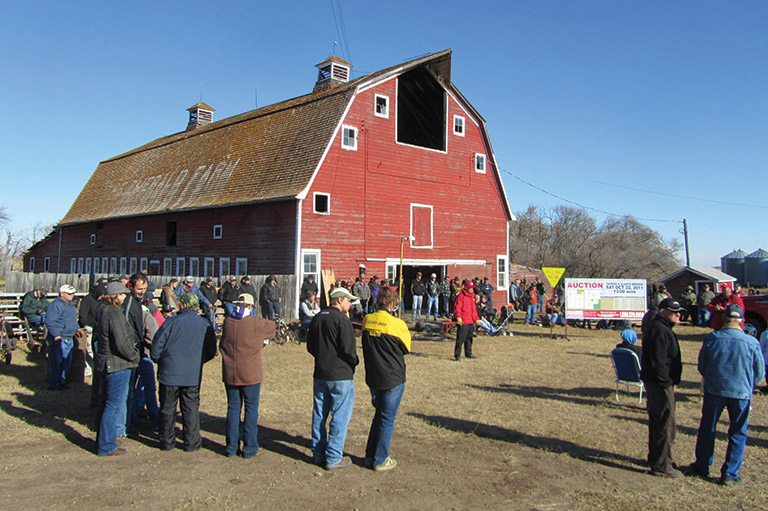
In 1911, Alex married local schoolteacher Annie Alicia Arkley. They built a white-and-green clapboard home and settled in to raise five children. George was the youngest. Tragically, the tuberculosis infection to which Alex had been exposed in Ireland became active, and he succumbed to the disease in 1936. George was eleven. The family continued to run the farm. One of Geroge’s older brothers, Colles, eventually left to establish his own farm. A second brother, Dick, followed a few years later to settle in North Battleford. Sisters Lilah and Muriel went on to become teachers, and George became the sole owner of the farm.
Six kilometres down the road from the Emerald Farm, Gladys Parker was following the trajectory of her own life. Also raised on a farm, Gladys had nine siblings and, like George, received most of her formal education at a one-room schoolhouse. Despite their proximity, the Parkers and the Brehons did not know each other well. Six kilometres was a fair distance in the 1930s, and the children attended different schools.
Eventually, George and Gladys got to know each other, and by 1952 they were married. They built their own house on the home quarter, with a split-level addition added in 1963. Together they raised four children. All were encouraged to go to college or university. Perhaps the parents hoped that at least one child would take over the farm. But none did. 
My wife, Leslie, the eldest, is a nurse and a teacher. I am also a teacher. Leslie’s brothers, Garth and Kevin, are engineers. It’s true that the “boys” often went to the farm to help with seeding and harvesting. There was even talk of having an extended family farm. But ultimately, Garth tells me, the farm would have to have been much bigger in order to support more than one family. Thus, most of their adult lives, and those of their children, have unfolded in the city.
Of the four siblings, only one is a farmer. Maureen farms with her husband on land only about ten kilometres away from the Brehon farm. But they have their hands full, for their sons, too, are working in the city.
The Emerald Farm, therefore, must go.
Save as much as 40% off the cover price! 4 issues per year as low as $29.95. Available in print and digital. Tariff-exempt!
On the morning of auction day, a cold, raw, late-October rain swept in and drenched everything in twenty minutes. The family rushed about throwing tarps over sale items. Those included a flatbed piled with mattresses and bed frames, boxes of magazines such as Popular Woodworking and Patchwork Quilts, children’s books, games, and vinyl albums — Tea for the Tillerman, anyone? There are also ranks of pickling bottles that will remain unsold. Is no one pickling anymore? The bottles are ultimately given to a lady for a token fifty cents, for everything must go. This is downsizing at its most elemental.
Some things are inexplicably in demand. The New World Standard Series DLE cream separator, still gleaming, is a coveted prize, going for a hundred and fifty dollars as a lawn ornament. Even the 1970s-era photocopier — which almost broke me when I helped carry it out of the basement room — goes quickly. And an inch-thick steel plate sells surprisingly well. Then the rain vanishes and the sun comes out to stay. There is still a cold wind, though. It cuts into us all. “Case 970 advertised with front-end loader, you betcha, tires on back in almost perfect condition.”
Though the auctioning did not begin till ten o’clock in the morning, the crowd began gathering at half past eight. There are old men present, but it is difficult to tell how old they are. Crow’s feet and a few days growth of beard seem to adorn young and old men alike. The average age looks to be around fifty. Everyone slumps in their jackets, bracing against the wind. The men wear baseball caps emblazoned with farm equipment logos or extolling the virtues of the Saskatchewan Wheat Pool. There is only one cowboy hat in the crowd — the man wearing it is probably visiting from Alberta. Or maybe he is from Sonningdale, a hamlet just across the North Saskatchewan River, yet seemingly a world away. The rest are probably locals from the RM of Mayfield — rural municipality to us city folk.
Most of the men are here for the bigger items — trucks, tractors, and parcels of land. They are clad in green or blue coveralls, tan-coloured jackets, and jeans of every shade. They’re wearing workboots or running shoes; it’s impossible to gauge who’s got money and who doesn’t. Everyone’s money is good for a bidding number. With a small nod, a tiny hand motion, or an upraised finger, they make their intentions known.
I make my way over to the household goods section, where Gladys is chatting with friends and relatives. After months of preparation and hard work, when I asked her how she was feeling, she said, “Relieved — and pleased to let the auctioneers do their job.”
“The kitchen cupboard is gone for fifteen dollars. Forty dollars takes the dresser. Five bucks on that blue table. You bought it, ma’am, for two dollars.”
I can only imagine what thoughts are going through Gladys’s mind. She has said that her fondest memories are of special family meals and events, of Christmas-time, with a big turkey and all the fixins’, and of harvest time, after the field crops and vegetables were safely stored, and the garden-grown pumpkins were distributed amongst the grandkids for carving into jack-o’-lanterns.
Dear Gladys. My thoughts waft to her kitchen, to the memory of her homemade bread and buns baked to perfection in her 1952 Frigidaire oven, an appliance bought new the year of her wedding and still ticking along today. To walk into Gladys’s kitchen at baking time was to walk into the fragrance of home — it enfolds you and holds you. It is in that domain that Gladys has made countless meals, great and small, for family, for hired men, and for crowds of friends and extended family.
The rest of Gladys’s gentle home also takes you into its embrace, with her exquisite needlepoint scenes of birds and flowers, her knitted rugs spread welcomingly in front of the living room rocking chair, couch, and La-Z-Boy, each with their own afghan blanket, and her patchwork quilts on all of the beds. The latter are the work of her hands, done in the company of the Maymont Quilters, a group of dedicated ladies, all now in their eighties and nineties, who have been getting together since the Second World War. When the first war bride arrived in the village in 1946, she received a quilt as a bridal shower gift. Since then, it’s been a tradition for new brides in the community to receive a quilt handmade by the ladies.
Gladys’s beautiful garden, too, is home, with its leafy rows of spuds and raspberry canes. During my visits over the years, I tried to earn my keep by picking endless buckets of berries, then going on cutworm patrol to protect my favourites — the beets — as well as the rhubarb, carrots, peas, and corn. Everything was either eaten fresh, made into heavenly jams and pies, bottled for the winter, or carried six metres down into the root cellar — or, as it was more aptly called, the potato pit.
Advertisement

As accomplished as she is, where Gladys really shines is in her ageless interaction with the young. Not many grandmas I know can chase down their eight-year-old grandson on a gravel road on the fly, in a foot of snow — and in her snowsuit, to boot.
“Fifteen, fifteen, fifteen, fifteen thousand, thank you, now twenty thousand....”
The day before the auction, I had walked around the home and its neat, immaculately mown yard. I had reflected on how the outdoors is always alive, with its own music, never silent, whatever the season. Years ago, I loved reading W.O. Mitchell’s classic novel Who Has Seen The Wind, about life growing up on the Saskatchewan prairie. I might not actually have seen the wind, but I could hear it roaring in my ears, could hear the rustling and sighing of the poplars.
On my walk, I hear the crunch of gravel as a pickup truck flies by on the grid road, throwing up a thin veil of dust. The road reminds me of the Brehon kids. Each of them took the bus to Maymont Central School, which was built in the early 1960s to replace the one-room schoolhouses of their parent’s day. The road also led to Saskatoon, an hour’s drive east, for the wildly anticipated twice-yearly visit to the dentist. And, of course, the same road took them into Maymont, where the family banked, checked in at the grain elevator, picked up groceries, saw the doctor, went to sporting events, and attended Sunday services at Sharon United Church.
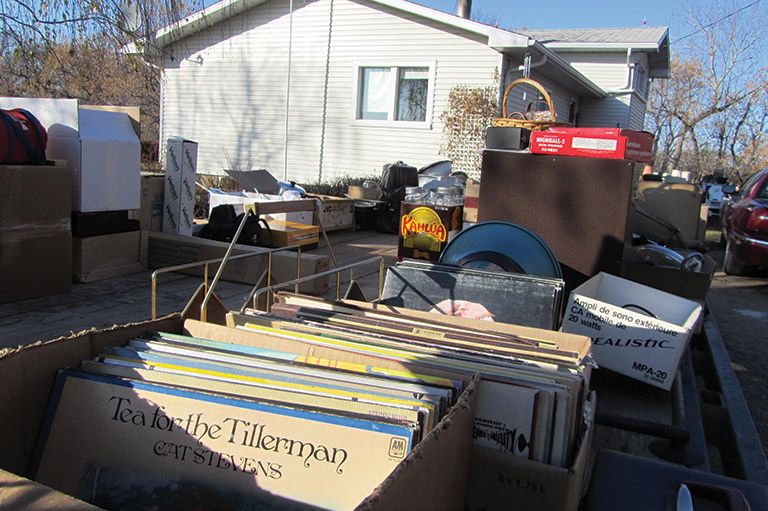
The church, built in 1911, was central to life in the community. During the week, young people went to meetings of the church equivalent of Girl Guides — Canadian Girls in Training (CGIT) — and Boy Scouts — Tyros for the younger boys. This same church was where all the Brehons — including my wife and I on one windy, hot July day — were married.
“What do I hear, what do I hear, what do I hear? We have a bid of five dollars….”
I hear the wind chimes in Gladys’s flower garden. I remember how beautifully it bloomed in summer. How did she get the peonies to grow so luxuriantly and get those cheerful orange prairie lilies to bloom along the north wall? I recall that even in midwinter’s darkness, the single string of multi-coloured Christmas lights that adorned the trimmed cotoneaster hedge called out a cheery welcome.
Inside the home are more memories that sing of family fun: of games of kaiser, crazy eights, cribbage, and crokinole, and Scrabble; of supper at six o’clock sharp, dinner at noon, and “lunch” late at night after another round of cards with visitors; of wiener roasts by the brick fire pit; of well water well mineralized; of “outside only” kitty cats crying for leftovers. If you listen carefully, you will hear the barking of the ghosts of farm dogs Pal and Mike and Jack. The latter was a German shepherd who lived to be seventeen years old — three times tumbling from the back of the pickup truck obviously did wonders for Jack’s constitution.
“Lot number thirty six, have a look at it guys, 4.3 litre, V6 engine, boy, would it be good on gas….”
I walk along the windbreak of western maple and poplar that Alex planted long ago and linger awhile at the machinery graveyard. There’s a 1970s Mercury Marquis 500, resting and rusting amidst waist-high wild oats and thistle. There’s a formidable old snow blower that George, the consummate handyman, built by himself. There’s an old tractor, a Massey-Harris, before it was Ferguson. There’s a venerable Co-op International combine. And, my favourite, an ancient wooden grain wagon. Here lies the twentieth century in repose.

“You set the price on it, fellers. Six thousand dollars to go. How ’bout it, eh? How ’bout six thousand six hundred, now seven thousand.”
I pass what remains of an old tree fort built by my son, William, and me. We built snow forts, box forts, hay bale forts, and one fort built from the remnants of a World War II plane. William grew up here on our many visits. I cross the east field, where I can see clearly for five kilometres before the horizon fades. Skeins of Canada geese fly overhead. A muskrat swims across the soon-to-be-frozen dugout — I remember how one Christmas Eve we all played a game of shinny there by the light of the Chevy half ton.
From the distance, to the southeast, I hear the woofing of a coyote, followed by yips and barks, and then the whole family joins in for a mad howl — the coyotes’ requiem for a day well spent as the daylight begins to fade.
I’m now at the grid road, the artery of all farming communities, and am off on a four-miler. We’re not in metric country here; the pattern of roads is etched into the land in mile-long blocks. Each square mile is a section, and each section is 640 acres. The average Saskatchewan farm nowadays is a little over two sections in size — about three and a half times bigger than when George and Gladys were growing up. Bigger farms mean fewer farms and fewer people living on them. And those left on the farm tend not to be young. The average age of a farm operator in Canada 2011 was fifty-four, up five years from the previous decade.
Advertisement
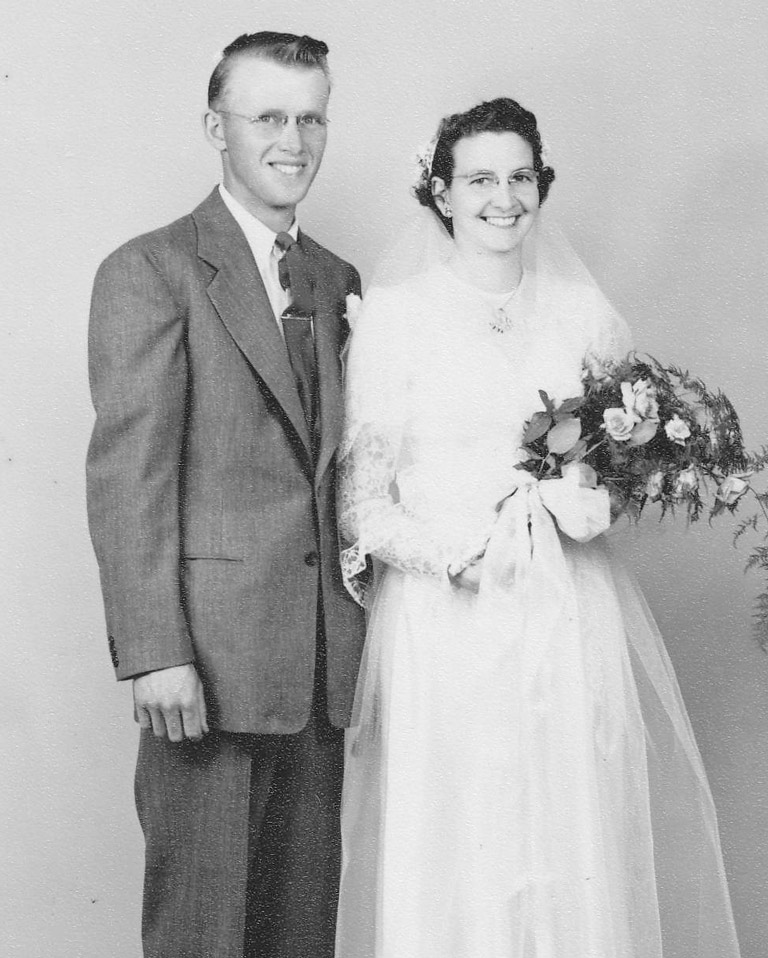
These realities, combined with changes in farming practices and transportation trends, have had a huge impact on villages like Maymont. Maymont was never big. Its population peaked at 239 in 1961. The census of 2006 listed its population as one hundred and thirty. I have witnessed its slow decline.
Maymont once had three grain elevators. Now it has none. I recall watching as the last one was dismantled for its wood. Then the bank went. And the grocery store packed up. Now the gas station is gone. Even the seniors centre is closed. Not everything is gone, though. You can still get coffee at the local hotel. And the school remains open, taking students from other districts where schools have been closed.
As I pass by the entrance to the home yard, I read a simple plaque proclaiming that the farm has been in one family for more than a hundred years. It reads: “The Brehon Family Farm, Established 1904, Saskatchewan Agriculture and Food, Hon. Mark Wartman, Minister.”
Every time I read it, I’m darned proud. And I think, once again, about the farm and my place in the scheme of things. Through the years, Leslie and I had thought, fleetingly, about the possibility of buying the farm, or at least part of it. But what do Leslie and I know about farming?
It would be hard to equal George. He was a great farmer, who grew cash crops of wheat, barley, and canola. In addition, he raised a hundred and fifty head of cattle, plus fields of oats and hay grown to feed them.
And as much as he was good on the land, he was an even better engineer. He could repair anything. He was furnace fixer extraordinaire for the RM and beyond –— a fundamentally important job when a furnace cuts out at minus thirty.
George was endlessly resourceful. Need a shop? No worries. Buy a filling station with its own shop, hydraulic lift included, put up for tender by the Saskatchewan Department of Highways. George got it to the farm himself, and for the next forty years the shop was his second home.

George was also a master of his metal lathes. And he loved to work with wood. He belonged to a highly capable generation who could do seemingly anything. My skills don’t compare.
Still, perhaps we should have bought a section and then rented it. Call it son-in-law’s remorse.
In the distance, I see three whitetail deer, their tails erect, leaping off into a copse of poplar. It brings to mind the time I saw a nine-point buck eying me fearlessly in the centre of the road. At other times I saw a badger bustling along a field of peas, fox kittens peeking out from their roadside den, and skunks galore. Some creatures I have seen in the past are rarely seen now. Hungarian partridges used to burst from the stubble, but they seem to be gone. I haven’t seen prairie chickens in years. Meadowlarks, with their piercing sweet trills, have gone silent.
I’m almost home now, nearing the access road, and the sun is setting in a swirling haze of molten apricot and mauve.
“Very low kilometres on this 1998 Chevy half ton. Eighty-one thousand complete.”
The twentieth century belonged to the Brehon family — former Prime Minister Wilfrid Laurier was right on their count, at least. The family was part of the massive immigration of homesteaders in the first decade of the century. It was part of World War I, where one of George’s uncles died at the front. It was part of the boom times and farm mechanization of the 1920s, when Alex Brehon hung on to his beloved horses for longer than economics would dictate.
Then came the grim years of the 1930s dust bowl — the Great Depression. The families of George and Gladys were luckier than some. Because they had arrived in the early 1900s, the Brehons and the Parkers were more firmly established than many who came later. The families had pigs, beef cattle, and dairy cows to keep them going, as well as enormous vegetable gardens. And, unlike the drought-stricken Palliser’s Triangle in the southwest of the province, the west central region of Saskatchewan received enough rain for crops to grow.
Advertisement
The outbreak of World War II led to dramatic changes. Young men of the area signed up with the navy and the air force. Gladys lost two cousins in Bomber Command. Young women left to earn steady paycheques in cities like Saskatoon, Vancouver, and Toronto. Gladys went to Vancouver in 1947, when she was twenty-one, and found work at Bartram’s Printing Company. The company made printed paper bags, and the women who worked there were known as, you guessed it, “Bartram’s Bags.”
She stayed less than a year. Upon the death of her mother in 1947, Gladys returned to her parents’ farm to help raise her younger sisters. The 1950s and 1960s were times of plenty. Improved farming methods and high grain prices allowed good farmers to thrive in the booming postwar economy. George’s mother, the indomitable Annie, born in 1885, was still on the farm. Widowed after Alex’s death in ‘36, she was a rock, co-managing the farm for many years. Annie lived to be ninety-three.
Through the 1970s and 1980s, the good times continued. The Brehon children were off to receive their post-secondary educations. By the 1980s, they were beginning to marry, and the elder Brehons became empty nesters.
With the 1990s came new challenges. Wheat was selling for not much more per bushel than it had in the twenties. Drought withered the crops. Fortunately, cattle prices kept the cash flowing on the Brehon farm.
The opening of the new millennium saw a reversal — higher prices for grain but uncertain prices for cattle. Mad cow disease and the vagaries of meat-packing plants now called the shots. As they entered their eighties, George and Gladys began to wind down. All around them, their contemporaries were passing away. By the end of 2011, three of George’s siblings — Colles, Dick, and Muriel — were gone. Lilah, however, is still going strong in Saskatoon, where she retired.
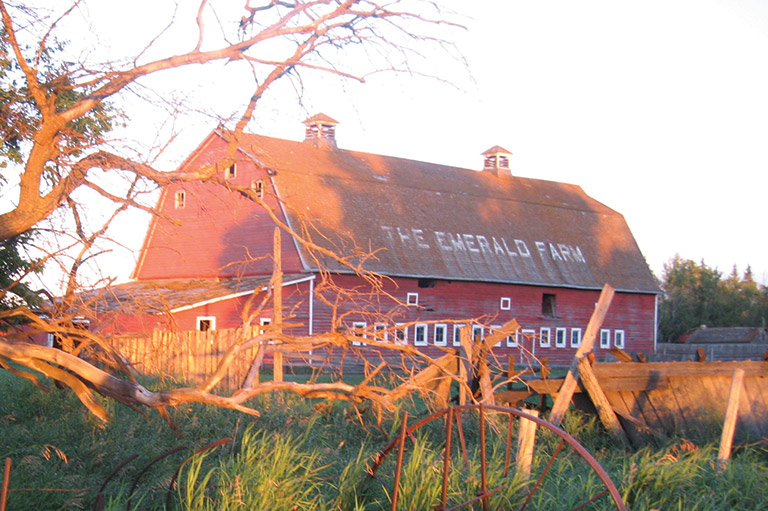
“Sixty-five thousand, sixty-five thousand, sixty-five thousand. Yeoh! Seventy thousand, seventy thousand. Yeoh!” It’s noon, and George and Gladys are sitting side by side on lawn chairs. Family members stand beside and behind them as the six parcels of their land, each of them a half square mile — a total of 1,920 acres — are auctioned one by one. Land prices are good, and the owners must okay any final bid. Some international bids come electronically, but the majority of the interest comes from people in the crowd. Within the hour, George and Gladys have agreed to the final bids, and it is done. The Emerald Farm, in all her Brehon family glory, has been sold.
“Does anyone want a stack of tires for a buck?”
The auction is winding down, and I slowly circle the yard. The auctioneers fight a losing battle to sell the leftovers as the four o’clock deadline approaches. The group of men holding bidding numbers dwindles. A last-gasp bidding war breaks out over a wind generator — the farm had electricity a full three decades before the public power grid came to this part of rural Saskatchewan in 1954.
“Time to pack ’er up, boys.”
I’m left standing in the yard, the sun beginning to set. I feel hollow, as I did when my brother and father died. With them went a part of me, and with the Emerald Farm went another part. A few successful bidders are towing away various farm implements. The auctioneers are gone. My wife,
Leslie, is stoic. The farm has always been her touchstone in our nomadic life. Knowing this is the right course of action doesn’t make it easier.
We are not alone. The same scenes play out across Canada — and across the world — as people move away from the land and into the cities. In Canada, Statistics Canada has for decades meticulously tracked the decline of the family-owned farm — the decline appears irreversible.
Most Canadians whose families have been in Canada for two generations or more don’t need to read the statistics. Most of us know of parents, grandparents, or great-grandparents being forced to sell the farm. Is it sad? For awhile, maybe. On the day of the auction, Garth told me it was a tough day for him, especially with those buying not knowing of, or caring about, the history behind their purchases. But he also said it was not nearly as tough as when his dad had been sick the winter before. He was proud of George and Gladys for having the remarkable courage and foresight to make the best decision.
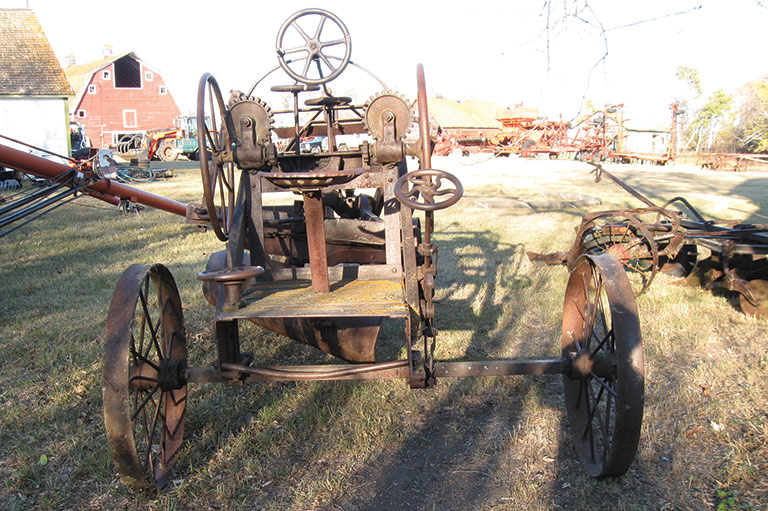
Is it wrong for family farms and the community life of small towns to fade away? No. How can it be wrong when many of the children of farmers are doing so well off the farm and increasingly large farms are needed to produce increasingly large amounts of food? It is simply life moving along.
Gladys and George are now settled in their comfortable condo in Saskatoon, happily learning a new rhythm. They live not far from their sons Garth and Kevin and not much more than an hour away from Maureen. Leslie and I, currently working at an international school in Cairo, are a day’s plane journey away. Within all of us, the Emerald Farm will live on.
To my remarkable parents-in-law, I leave the final word: “Farming as we have known it has been part of a great history in Canada, and we’re proud to have lived it.”
At Canada’s History, we highlight our nation’s past by telling stories that illuminate the people, places, and events that unite us as Canadians, while understanding that diverse past experiences can shape multiple perceptions of our history.
Canada’s History is a registered charity. Generous contributions from readers like you help us explore and celebrate Canada’s diverse stories and make them accessible to all through our free online content.
Please donate to Canada’s History today. Thank you!
Themes associated with this article
Advertisement



